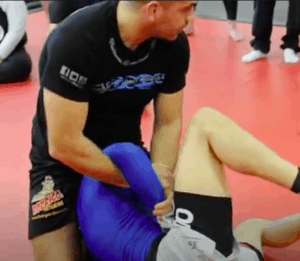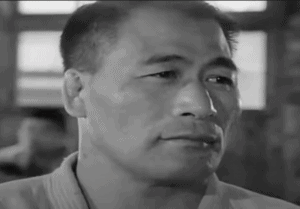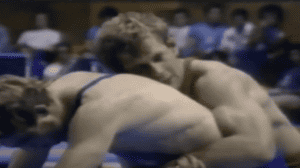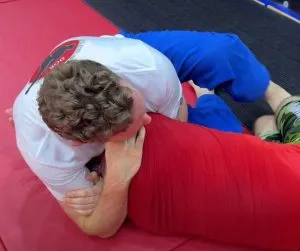If you want to be a great submission grappler or an overall great fighter, you need to learn the Kimura lock as it is the bread and butter of BJJ submissions and can be used in many different positions and grappling scenarios.
If you’re a mixed martial arts fan, you’ve most likely heard of the devastating armlock that is the Kimura. Among the most brutal submissions the UFC has witnessed was the Kimura finish delivered by Frank Mir against Minotauro Noguiera, which ended with Mir breaking Noguiera’s arm for a submission finish. Frank Mir’s display of the Kimura submission dominance and clear understanding of the technique rendered Noguiera’s escape attempts futile.

World-renowned Brazilian Jiu-Jitsu Coaches Vagner Rocha, Chris Brennan, Ryan Hall, Mario Sperry and John Danaher are notorious for their Kimura submissions and Kimura systems. Rafa Mendes and Keenan Cornelius are also known to use the Kimura armlock transitionally in their setup.
The Kimura lock doesn’t leave much room for error with this tight hold on anyone’s arm!
When the fighter ties the Kimura and puts tremendous pressure on the opponent’s shoulder, the opponent is immobilized. Without much room to move and counter, the opponent will have no choice but to tap (or get injured). This is why the Kimura lock ranks among the top Brazilian Jiu-Jitsu submissions with the highest success rates.
Let’s get to know the Kimura armlock better.
What is the Kimura Armlock?
The Kimura Lock is named after the famous Japanese judoka Masahiko Kimura. While judo predominantly focuses on throws, judokas also use armlocks and chokes to submit their opponents. It was on October 23, 1951 Masahiko Kimura faced off against the founder of Brazilian Jiu-jitsu Helio Gracie and ended up submitting Helio Gracie early in the second round of their match by way of what is now known as the Kimura. This led to the lock being named the “Kimura” by BJJ practitioners and the emphasis on learning and perfecting the Kimura lock.

Technically speaking, the Kimura is a double joint arm lock used in Brazilian jiu-jitsu, grappling, catch wrestling, and judo. It is one of the first submissions that you’ll learn when you train BJJ and can be seen to be effectively used in all levels of competition, from white belt to black belt.
The great thing about the Kimura is that the submission can be applied from many different positions such as closed guard, half guard, side control, etc.
In order to successfully perform the Kimura lock, you’ll want to stabilize your hold on your opponent. If you’re performing the Kimura from side control, your opponent’s back has to be flat on the mats, otherwise, it can be easy to counter your Kimura. Whatever your position is, keep them immobilized and always remember the golden rule of BJJ, position before submission. This means make sure you are in a proper position prior to trying to perform the Kimura.
The first thing that you’ll want to learn is the figure-four lock around your opponent’s arm. The closed-loop around a joint – the wrist, in this case – stabilizes your grip so you can transition to isolate the limb.
Using the same-side hand, you need to take control of your opponent’s wrist and use your cross arm to overhook your opponent’s arm. Loop behind and under and grab your own wrist to form the figure-four lock.
You can use the monkey-grip or the C-grip. The C-grip is generally better for the beginning moments of the submission attack as you have much better control of the opponent’s wrist whereas the monkey grip is much better towards the end of the submission attempt and movement as you can better relax your gripping arm.
The important thing is maintaining this lock so that it stands up to your opponent’s resistance. To add a little spice to your armlock, try switching it up and using the monkey grip when you’ve achieved that perfect Kimura position. This will force emphasis in both directions without needing as much pressure from yourself since there’s nothing holding onto them so they’re free once again.
Once you’ve established this position, you won’t need to rush towards submission. The Kimura quickly reduces your opponent’s margin for escape, so you can take your time in securing the submission all the way through. You increase your opponent’s chances of escape when you rush through this or when you get complacent.
Your Kimura lock should force your opponent’s arm into a 90-degree bend, the weakest position their arm could get. Now it’s time to leverage your body to finish the submission.
Even if you’re strong, your opponent could tire you out easily when they grab their gi or leg. The most efficient way to finish a Kimura is to leverage your entire body to completely isolate the arm to one side and then bring the arm to an acute angle. Deliver consistent pressure and try to bring your opponent’s arm towards the head. You are essentially moving their arm from the front of your opponent’s body to the back.
Why Should You Learn the Kimura Lock?
This technique is incredibly versatile. Aside from using it to submit your opponent, you can also use the Kimura armlock to escape your opponent, deliver a sweep, or force them into a setup.
While your opponent is in your closed guard, you can attempt a Kimura. When they posture up or struggle to free their arm, this is your queue to force a Kimura hip bump sweep. When you’re in a half-guard position, you can use a Kimura to sweep your opponent. You can also use a Kimura to transition into a heel hook.
Keenan Cornelius says that whenever his training partner’s arm ends up anywhere between their knees and mid-chest, Keenan will show that this is an opportunity for him to trap them in a “Kimura.” Furthermore, the BJJ legend says that the Kimura is useful to reverse your opponent’s attack.
If your opponent gets your back in a takedown attempt, you can push their arms down to break their grip and then set up your figure-four lock, slowly turn in towards your opponent while lifting their elbow high. This puts pressure on their shoulders. You can finish this standing or take it to the ground.
Last but not least is the ability to use the Kimura when standing up and defending the single leg takedown, this is called the Kimura-trap and is a highly effective method at defending the single leg with countering into a throw and submission chain that ends with the Kimura being applied from a superior top position on the opponent.
Final Thoughts
It takes constant practice and drills to master the Kimura. This is going to be worth it because once you’ve mastered the Kimura lock, you’ll find so many opportunities to execute this technique during every roll and every match.
If you’re a beginner, be careful when you execute your Kimuras because it’s easy to injure your training partner when you’re not careful. If you’re already a novice or are into competitive BJJ and the Kimura system isn’t your go-to submission, it’s well worth exploring.
Brazilian Jiu-Jitsu is a game of leverage, and Kimura is a must-have in your BJJ arsenal. This isn’t “just a shoulder lock.” The Kimura armlock gives you the mechanical efficiency to effectively pin your opponent down, force them into a setup without wearing yourself out, or win via submission.




